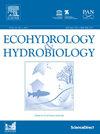水螅体对气候变化引起的海水温度急剧升高的耐受性如何?北极Dynamena pumila (L., 1758)的个案研究
IF 2.7
4区 环境科学与生态学
Q2 ECOLOGY
引用次数: 0
摘要
在未来的几十年里,北极水层的温度可能会显著升高。浅水动物将在多大程度上受到气候变暖的影响?我们以一种殖民地水螅(Dynamena pumila)为例研究了这个问题。通过脉动活动和匍匐茎生长来判断其对变暖的反应。群落水螅体中小圆弧的脉动是机体对环境因素影响反应的敏感指标。我们测试了D. pumila菌落在25°C环境下生存和适应5天的能力。温度从14℃升高到25℃后,第一天的菌落生长和匍匐茎生长尖的脉动均呈先上升后下降的趋势。在接下来的几天里,生长的脉动几乎停止了,菌落停止了生长,它们的小叶柄开始从叶柄上脱落。然而,到了第四天,这一进程减慢了,殖民地处于一种经历不利条件的经济模式中。热冲击在实验中持续了5天。温度从25℃降至15-16℃后,菌落在5天内全部恢复并继续生长。本文章由计算机程序翻译,如有差异,请以英文原文为准。
How Tolerant Are Hydroids to Climate-Change-Induced Acute Spikes in Sea Water Temperature? A Case Study of Arctic Dynamena pumila (L., 1758)
The temperature of the water surface layer in the Arctic may increase significantly in the coming decades. To what extent will shallow-water fauna be affected by warming? We investigated this issue using an example of one species of colonial hydroid, Dynamena pumila. We judged its reaction to warming via its pulsation activity and the growth of stolons. Pulsations of the coenosarc in colonial hydroids are a sensitive indicator of the body’s reaction to the influence of environmental factors. We tested the ability of D. pumila colonies to survive and adapt to existing at 25 °C for five days. After raising the temperature from 14 °C to 25 °C, colony growth and the pulsation of stolon growth tips on the first day increased and then decreased during the day. In the following days, the growth pulsations almost ceased, the colonies stopped growing, and their coenosarcs began to exfoliate from their perisarcs. However, by the fourth day, this process slowed down, and the colonies existed in an economy mode of experiencing unfavourable conditions. The thermal shock continued in the experiment for five days. Then, after the temperature dropped from 25 °C to 15–16 °C, all the colonies recovered within five days and continued to grow.
求助全文
通过发布文献求助,成功后即可免费获取论文全文。
去求助
来源期刊

Ecohydrology & Hydrobiology
Agricultural and Biological Sciences-Aquatic Science
CiteScore
5.40
自引率
3.80%
发文量
51
期刊介绍:
Ecohydrology & Hydrobiology is an international journal that aims to advance ecohydrology as the study of the interplay between ecological and hydrological processes from molecular to river basin scales, and to promote its implementation as an integrative management tool to harmonize societal needs with biosphere potential.
 求助内容:
求助内容: 应助结果提醒方式:
应助结果提醒方式:


